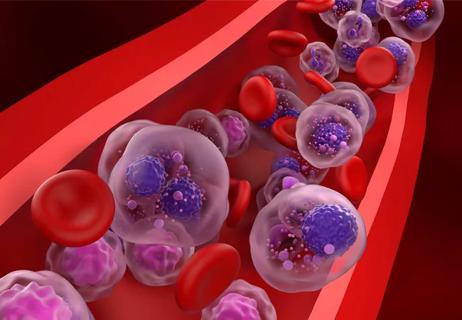Strategies and risk models are evolving for this asymptomatic condition

What do you do when a patient presents with M protein in their blood or urine, but no signs of active multiple myeloma? Often these patients have what is considered smoldering multiple myeloma (SMM): That is, abnormal lab tests but no active disease. Although there is much debate about whether or not to treat these patients, there is progress that has been made in understanding this condition.
Advertisement
Cleveland Clinic is a non-profit academic medical center. Advertising on our site helps support our mission. We do not endorse non-Cleveland Clinic products or services. Policy
The big question is what is the patient’s risk of progressing to multiple myeloma (MM)? Some patients remain in the “smoldering” category for years, others progress rapidly and still others do not contract MM at all. Risk stratification has evolved in recent years, with the International Myeloma Working Group identifying risk factors that predict progression within two years:
Risk factors:
Additionally, genetic features of t(4;14), t(14;16), +1q, and del13q/monosomy 13 by fluorescence in situ hybridization (FISH) were identified as higher risk.

Image content: This image is available to view online.
View image online (https://assets.clevelandclinic.org/transform/bea51612-93a9-4610-84c5-feac7f4fb93f/smoldering-myeloma-chart-updated)
As one of the largest MM practices in the U.S., Cleveland Clinic Cancer Center specializes in caring for many patients with SMM. Today, ConsultQD had the chance to speak with Cleveland Clinic Cancer Center hematologist Shahzad Raza, MD about the work being done to better ascertain answers to pressing questions about SMM.
NCCN guidelines recommend clinical trial enrollments for these patients or watchful observation or lenalidomide in selected patients. At Cleveland Clinic, the first step is counseling patients with smoldering myeloma and providing a realistic assessment of risk of disease progression.
“We still have a lot of work to do in terms of understanding patients with high-risk smoldering myeloma, whose risk of progression within two years is up to 70%,” says Dr. Raza. “This is still a matter of debate about deciding on observation versus systemic treatment. As we know, not everyone progresses, and our risk stratification models are not perfect. Some of these patients don’t progress and do not need chemotherapy. There are many clinical trials underway to help improve classification and overall outcomes. At many centers like Cleveland Clinic, watchful waiting is the recommendation, until our current risk stratification model is further validated in clinical trials and therapy is offered to patients who will likely progress with high certainty. “
Advertisement
The Myeloma team watches patients closely every three to four months, checking blood counts and performing PET scans or MRIs to check for bone disease. Bone marrow biopsies are part of the workup, and this includes evaluating whether the patient’s abnormal cells are indicative of aggressive disease or not. If so, this would necessitate closer monitoring. Treatment is initiated if the condition progressed to active MM.
Concerns over the toxicity of treatment have led many clinicians to take this more conservative approach. Although there are some clinical trials underway to evaluate whether newer medications like daratumumab can stave off progression, the backbone of most trial protocols for this purpose is still lenolidomide, which comes with its own challenges. “Lenolidomide puts patients at increased risk of blood clots and there is a risk of secondary cancers after prolonged use. Side effects such as abdominal toxicities and fatigue are common. “We have to balance the risk versus the benefits,” says Dr. Raza. “If a patient is symptomatic, there is a reason to treat them because we want to minimize any damage occurring, but if we treat someone who just has an abnormal number but not active disease, there is no consensus about whether to do so.”
Some clinical trials indicate that early intervention can slow progression, but the question remains whether this improves patients’ overall survival.
Being diagnosed with SMM comes with a good deal of anxiety, and patients often want to know what they can do to minimize the risk of getting MM. Questions about diet and exercise often arise. Dr. Raza noted a healthy lifestyle and exercise will help patients tolerate treatment and improve their quality of life if they do progress to MM.
Advertisement
“If someone has a fatty diet, they are at increased risk of obesity, which can increase risk of complications such as blood clots,” explains Dr. Raza. “Similarly, if someone has diabetes, that is a confounding factor anyone with MM. Steroids are part of MM treatment, and these can cause hyperglycemia crises and other issues.
While there are still many unknowns about addressing SMM, there is hope for more definitive answers. Some therapies are being tested concurrently for SMM. “We hope to know soon what the data shows for these therapies and whether there is an overall survival benefit of using these therapies early for asymptomatic patients.”
Advertisement
Advertisement

Phase 2 study brings pivotal advances in treatment efficacy and safety for the most challenging-to-treat population

Making sense of the fast-moving treatment landscape

Explaining common misconceptions about chimeric antigen receptor therapy

Clinicians share practices to streamline initiation of care

Prediction and bioinformatic data could prove valuable for therapeutic interventions targeting this malignancy

Findings from large database important to inform clinical practice

Study of 401,576 patients reveals differences in cancer burdens as well as overall survival

Despite sicker patients, response rates of teclistamab in a real-world study were similar to those from a pivotal clinical trial